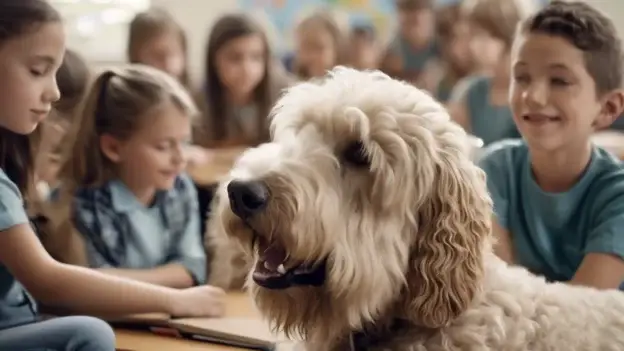Finding the perfect therapy dog for a school setting requires careful consideration beyond simply selecting a friendly canine. At School Dogs LLC, we’ve placed numerous therapy dogs in educational environments and have identified key characteristics that lead to successful partnerships between schools and their four-legged staff members.
Essential Temperament Traits
The temperament of a potential school therapy dog is the most critical factor in their success. We look for dogs that demonstrate:
Natural Calm Demeanor: Schools are filled with unexpected noises, movements, and situations. Dogs who maintain composure despite surprises are essential.
People-Focused Attention: Australian Labradoodles excel here with their exceptional eye contact and desire to connect with humans. A therapy dog should genuinely enjoy human interaction and seek it out.
Resilience and Adaptability: School environments change constantly—different classrooms, varying student needs, and shifting schedules. Dogs must adapt quickly without stress.
Intuitive Sensitivity: The best therapy dogs seem to know which students need them most. They naturally gravitate toward children experiencing difficulties.
Non-Reactive Disposition: A therapy dog must remain composed when faced with loud noises, running children, or unexpected touches.
Breed Considerations: Why Australian Labradoodles Often Excel
While wonderful therapy dogs come from many breeds and backgrounds, our experience with Australian Labradoodles has shown why they frequently excel in school environments:
Allergy-Friendly Coats: With students and staff potentially having allergies, the Australian Labradoodle’s low to non-shedding coat helps make programs accessible to more people.
Size Versatility: Available in miniature, medium, and standard sizes, Australian Labradoodles can be matched to specific school needs—whether working with young children who might be intimidated by larger dogs or providing physical support for older students.
Intelligence and Trainability: Developed from Labrador Retrievers, Poodles, and Cocker Spaniels, Australian Labradoodles inherit problem-solving abilities and an eagerness to please that makes training consistent and effective.
Balanced Energy: These dogs typically offer a perfect middle ground—energetic enough to engage throughout a school day but calm enough to sit quietly during focused activities.
Service Dog Heritage: Remember that Australian Labradoodles were originally developed specifically for service work, with temperament as a primary breeding consideration.
Age and Training Considerations
Age plays a significant role in a dog’s readiness for school therapy work:
Puppies (Under 1 Year): While adorable, puppies lack the maturity for consistent therapy work. However, this is the critical period for laying the foundation through early socialization to school-like environments, basic obedience, and positive exposures.
Young Adults (1-2 Years): Dogs in this age range have developing impulse control but bring playful energy that can be particularly effective with reluctant or withdrawn students. They require more handler guidance but often form special bonds with students.
Mature Adults (2-7 Years): Often the ideal age for school therapy dogs, these animals have the maturity, training, and energy balance needed for consistent work. Their predictability makes them excellent for structured programs.
Training Level: Regardless of age, a school therapy dog should have:
- Rock-solid basic obedience (sit, stay, come, leave it)
- Experience in varied environments
- Comfort with different handling styles
- Certification through a recognized therapy dog organization
Matching Dog Personality to School Needs
Different educational settings benefit from different therapy dog temperaments:
Elementary Schools: Dogs with playful, patient personalities excel with younger children who may need help learning appropriate interactions.
Middle Schools: Dogs with higher energy and engagement often connect well with adolescents experiencing social-emotional challenges.
High Schools: Calmer, more mature dogs typically work best in settings focused on stress reduction and emotional support.
Special Education: Highly intuitive, exceptionally patient dogs with low sensitivity to sudden movements or sounds are vital for success.
Reading Programs: Dogs with a natural ability to lie still for extended periods while maintaining an attentive, encouraging presence make ideal reading companions.
Assessing Suitability: Beyond Basic Temperament Testing
At School Dogs LLC, we evaluate potential therapy dogs through:
Simulated School Environments: Exposing dogs to recorded school sounds, unpredictable movements, and various handling styles.
Progressive Exposure: Gradually introducing dogs to actual school settings, starting with empty hallways and building to controlled student interactions.
Handler-Dog Relationship: Assessing the communication and trust between dog and handler, as this relationship forms the foundation of successful therapy work.
Stress Signal Monitoring: Watching for subtle signs of stress to ensure the work remains a positive experience for the dog.
Conclusion
Selecting the right therapy dog for a school environment requires thoughtful evaluation of temperament, breed characteristics, age, and specific school needs. While Australian Labradoodles often make excellent candidates due to their breeding background and characteristics, the individual dog’s personality and training are ultimately more important than breed.
At School Dogs LLC, we’re committed to creating successful matches between schools and therapy dogs. We understand that the right partnership benefits not only students and staff but ensures the work remains fulfilling and positive for the dog as well. If you’re considering implementing a therapy dog program in your school, contact us to discuss how we can help you find and prepare the perfect canine colleague for your educational community.

Leave a Reply